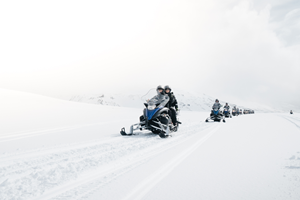Weather in March
In March the weather begins to get warmer but it is still winter time so you should be prepared for snow and cold weather. March is also one of the wettest month of the year with average precipitation of 82mm, you can basically expect everything in March rain, sunshine, snow, storms and blizzards.
The average temperature in March is around 0,5°C (33°F) and the average sunshine is 111 hours, so it is getting brighter during the day. You can still see the Northern Lights in March and that is usually the last good month to see the Northern Lights in Iceland.

Driving in Iceland in March
If you are planning on renting a car in March you can of course do that but we recommend renting a 4WD car with good winter tires and only if you are confident and used to driving in cold weather conditions.
Driving during the winter in Iceland can be difficult and dangerous as there can be ice or snow on the road and sometimes a blizzard and a complete white out. It is important to always check road and weather conditions before driving in Iceland during the winter. In March many roads in Iceland are impassable especially in the most remote areas in the Westfjords, North and East also the mountain roads are closed.
There is usually a good winter service on the main roads and the most popular tourist destinations around Reykjavík are accessible including the Golden Circle, the South Coast as well as Snæfellsnes peninsula in the West and the North part of Iceland.
If you are not comfortable driving multiple bus tours and private tours are available during the winter in Iceland.
If you decide to drive in Iceland here you will find useful tips and more extensive information.

What to wear
The spring in Iceland is usually warmer than the winter but it is still cold, the average temperature during the spring is around 3°C (37,4°F), but with the wind it feels colder.
You can expect all kinds of weather in March, snow, rain, storms and fortunately we have sunny weather to. The weather is also very unpredictable and changes very fast from being sunny to raining and even snow blizzards.
So we recommend that you bring layers of clothes with you especially good rain gear, hiking shoes and warm base layer.
- Hiking boots - If you are planning on only staying in Reykjavík then sneakers might be enough but if you will be travelling around the country and staying outside you need good hiking shoes that will keep you warm.
- Base layer - warm layers under the clothes might be the best thing you bring to Iceland. We recommend wearing long wool or thermal underwear, you can buy it in outdoor clothing stores in Iceland.
- Fleece or wool - The icelandic wool sweater or fleece is a must. The icelandic wool sweater can be bought all over the country in local stores.
- Parka or water and windproof jacket - You want to wear the parka on cold days but it might also rain during the winter so a water and windproof jacket over the wool/fleece sweater is essential.
- Water and windproof pants - It is windy in Iceland and it rains so bring the pants.
- Hats, gloves and warm socks - Bring at least two sets of everything a lighter pair and a thick one as well.
- Swimsuit - You are going to want to relax in our warm swimming pools or hot springs after a long day outside
Quick info
Average temperature: 0,5°C/33°F
Average sunshine: 111 hours
Average precipitation: 82 mm



